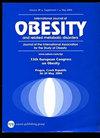针对小学弱势儿童超重问题的健康促进计划(BeE-school)的效果:分组随机对照试验
IF 4.2
2区 医学
Q1 ENDOCRINOLOGY & METABOLISM
引用次数: 0
摘要
背景:肥胖症是一种复杂的多因素疾病,在全球的发病率不断上升。考虑到肥胖与较低的社会经济地位密切相关,在弱势学龄儿童中实施肥胖预防计划尤为重要。这项分组随机对照试验旨在评估针对小学弱势儿童超重问题的健康促进计划的有效性:BeE-school研究涉及葡萄牙北部地区10所小学的735名儿童(51.7%为男孩,平均年龄为7.7(1.2)岁),这些学校被确定为优先干预教育地区。经过初步评估后,这些学校被随机分为两组:一组接受干预(4 所学校,n = 353),另一组不接受干预(6 所学校,n = 382)。干预措施包括对教师进行为期 16 周的教育和培训,在课堂上实施,并在此期间每两周向家庭提出一次挑战。我们对该计划的短期效果(95.5% 的参与者)和长期效果(50.8% 的参与者)进行了评估,前者是干预后立即进行的评估,后者是干预一年后进行的评估。我们考虑了从基线到干预后和随访评估期间体重指数 z 值(BMIz)、腰围与身高比率和腰围与体重比率的差异:干预后,受干预儿童的三项脂肪含量指标均有显著下降:BMIz (B = -0.098, 95% CI: -0.156 to -0.040, p = 0.001)、腰围与身高的比率 (B = -0.007, 95% CI: -0.010 to -0.003, p 结论:干预后的儿童在三项脂肪含量指标上都有明显下降:结论事实证明,以学校为基础、以教师健康促进培训和家庭参与为重点的干预措施能有效改善社会弱势儿童的身体成分。本文章由计算机程序翻译,如有差异,请以英文原文为准。

Effectiveness of a health promotion program on overweight in vulnerable children from primary schools (BeE-school): A cluster-randomized controlled trial
Obesity is a complex, multifactorial disease with rising global prevalence. Considering its significant association with lower socioeconomic status, implementing obesity prevention programs in vulnerable school-age children is particularly pertinent. This cluster-randomized controlled trial aims to evaluate the effectiveness of a health promotion program on overweight in vulnerable children from primary schools. The BeE-school study involved 735 children (51.7% boys, average age 7.7 (1.2) years old) from 10 primary schools in the Northern region of Portugal, identified as Educational Territories for Priority Intervention. After the initial assessment, the schools were randomized into two groups: one receiving the intervention (4 schools, n = 353) and the other not (6 schools, n = 382). The intervention included education and training teachers for 16 weeks, their implementation in the classroom, and giving families challenges every two weeks during this length of time. The program’s effectiveness was assessed short-term, immediately post-intervention (for 95.5% of participants) and long-term, one year after (for 50.8%). We considered the difference in BMI z-scores (BMIz), waist-to-height ratio and waist-to-weight ratio, from baseline to post-intervention and follow-up assessment. In post-intervention, intervened children presented a significant reduction in all the three measures of adiposity: BMIz (B = −0.098, 95% CI: −0.156 to −0.040, p = 0.001), waist-to-height ratio (B = −0.007, 95% CI: −0.010 to −0.003, p < 0.001) and waist-to-weight ratio (B = −0.121, 95% CI: −0.193 to −0.048, p = 0.001). One year after the intervention ended the decrease in BMIz remained significant (B = −0.114, 95% CI: −0.213 to −0.015, p = 0.023). Conclusion: The school-based intervention, focusing on teacher training in health promotion and involving families, proved to be effective in improving body composition in socially vulnerable children.
求助全文
通过发布文献求助,成功后即可免费获取论文全文。
去求助
来源期刊

International Journal of Obesity
医学-内分泌学与代谢
CiteScore
10.00
自引率
2.00%
发文量
221
审稿时长
3 months
期刊介绍:
The International Journal of Obesity is a multi-disciplinary forum for research describing basic, clinical and applied studies in biochemistry, physiology, genetics and nutrition, molecular, metabolic, psychological and epidemiological aspects of obesity and related disorders.
We publish a range of content types including original research articles, technical reports, reviews, correspondence and brief communications that elaborate on significant advances in the field and cover topical issues.
 求助内容:
求助内容: 应助结果提醒方式:
应助结果提醒方式:


